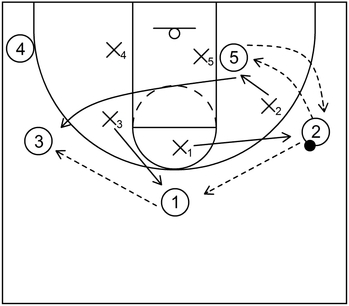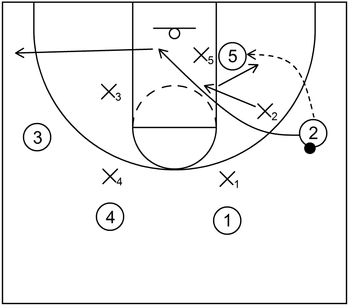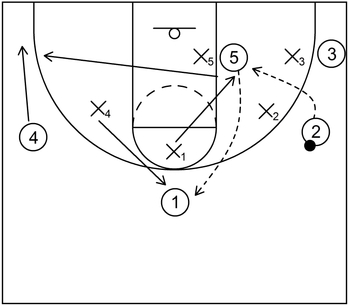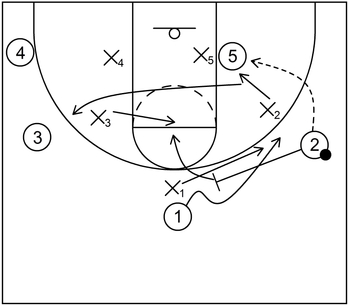What is a double team in basketball
The double team is a defensive tactic that occurs when an offensive player in possession of the basketball receives simultaneous defensive pressure from a primary defender and a secondary defender, ultimately to limit or totally prevent scoring opportunities, particularly near the basket or near perimeter areas of the court.
Who is the primary defender of a double team
The primary defender is the on-ball defender that is initially assigned to guard the offensive player with the ball.
In terms of standard basketball positions, if the ball is on the perimeter such as the top, wings, or corners, then the on-ball defender is typically a point guard, shooting guard, or small forward.
On the other hand, if the ball is near the low post area, then the on-ball defender is usually a power forward or center.
Who is the secondary defender of a double team
The secondary defender is an initial off-ball defender that will leave (i.e. move away from) their own assigned offensive player to execute a double team with the primary defender against a player with the ball.
What are general advantages of a double team
Advantage #1
A noteworthy advantage of executing the double team is that the additional defensive pressure, particularly from the secondary defender, could cause the player with the ball to go too fast. This, in turn, could lead to potential turnovers or questionable shot selection.
For example, if a player with the ball receives the double team, then that same player might pick up their dribble quicker than they preferred and then they might turn the ball over by way of a bad pass to another teammate.
Advantage #2
Another advantage of executing the double team is that it could limit or prevent easy scoring opportunities for the offensive team in general as well as the offensive team’s best player.
In other words, if the offensive team prefers to let one player do most of the team’s scoring, then setting up a double team to limit that player’s offensive productivity may prove to be useful for the defensive team.
That could potentially be even more beneficial if that offensive player is a low post player. Essentially, it is usually much more effective to double team a low post player as opposed to a perimeter player.
The main reason being that it is typically easier to provide proper defensive rotations, particularly on the weak side of the court.
Furthermore, it should be noted that many teams may prefer to double team the low post player simply to influence that player into passing the ball back towards the perimeter and away from the basket.
Theoretically speaking, when the ball gets passed away from the basket, this usually decreases the shot making percentages for the offensive team, especially if the offensive team only has average or below average three-point shooters. That, of course, would be favorable for the defensive team.
What is a general disadvantage of a double team
The biggest disadvantage of the double team is that an offensive player without the ball will typically be open, at least temporarily.
It should be noted though that this could get mitigated to a degree by implementing defensive rotations, particularly with weak side help defense.
However, if the defensive team does not execute proper defensive rotations or those rotations are poorly executed, then the offensive team will most likely receive an open jump shot near the perimeter or an open layup or dunk at the basket.
What are the general techniques to execute a double team
Technique #1
The first technique to execute a double team is to consider the timing of it. While it is possible to initiate the double team at any particular time during the defensive sequence, the usual best time to execute it is after the player with the ball already started their dribble or just finished their dribble.
If the player with the ball started their dribble, then the defensive pressure from the double team could cause them to prematurely pick up their dribble. When that mistake occurs, the player with the ball could compound the problem by executing a bad pass, which then could lead to a turnover.
Likewise, if the player with the ball already ended their dribble, then the double team pressure could cause the player to get rid of the ball impulsively leading to a intercepted pass or some other type of turnover such as a traveling violation.
Technique #2
The second technique to execute a double team is for the primary defender and secondary defender to place their adjacent feet next to each other (i.e. lock their feet together) as a method to prevent a potential dribbling escape route for the player with the ball.
In other words, if the player with the ball did not already begin or end their dribble at the onset of the double team tactic, then the primary defender and secondary defender should not allow the offensive player to break the pressure by splitting the double team or by easily dribbling around it.
Technique #3
The third technique to execute a double team is for the primary defender and secondary defender to use high hands to make it more difficult for the player with the ball to see potential passing options out of the double team.
Moreover, the primary defender and secondary defender should use their high hands to mirror the hands of the player with the ball.
As a result of mirroring, one of the defenders could possibly deflect an attempted pass from the player with the ball, and this could lead to a turnover.
Additionally, it is important for the primary defender and secondary defender to not reach for the ball in an attempt to steal it from the offensive player. This could cause the primary defender or secondary defender to receive an unnecessary foul.
Affiliate Disclosure: I may earn a commission on qualifying purchases made through the links below.
What are basic examples of double teams with defensive rotations
Example 1

This is an example of a double team when the ball gets passed into the low post and the player executing the pass is not a good three-point shooter. Furthermore, the example demonstrates what could happen if the ball gets passed back towards the perimeter.
To start, 5 receives the ball from 2 and when that occurs, X2 moves away from 2 to execute a double team alongside X5.
From that point, because of the double team tactic, 2 receives the ball back from 5 and as that occurs, X1 executes a closeout to defend against 2.
X1 executes the closeout on 2 near the wing because X2 probably would not have enough time to recover after releasing from the double team. Additionally, X1 could also prevent an uncontested jump shot or easy dribble drive to the lane.
Furthermore as X1 executes the closeout on 2, the weak side defender, X3 executes a closeout on 1, particularly as 1 receives the ball from 2.
Additionally, as those closeouts occur, X2 sprints across the lane to defend against 3 near the left side wing. Therefore, if 3 receives the ball from 1, then 3 cannot take an uncontested jump shot or easily drive to the basket with no defensive resistance.
Example 2

This is another example of a double team that could occur after a player passes the ball into the low post and then cuts through to the weak side corner. This example is also derived from Building a Championship Defense by Matt Painter.
To start, 5 receives the ball in the low post from 2. Afterwards, 2 cuts through the lane towards the left side corner. As 2 cuts through the lane, X2 mirrors 2 path with proper defensive sliding and then touches a piece of the paint.
Following that, as 2 continues to cut through, X2 quickly turns and immediately executes a double team with X5 against 5.
It is also important to note that as 2 cuts through, X2 must touch a part of the paint because of X2 executes the double team too early, then 5 could simply execute a short pass while 2 is still in the paint.
After that occurs, 2 could simply score near the basket which is not what the defense desires. Also, it should be noted that for this example that once 2 cuts through to the left side corner, X3 should stand in the gap between 2 and their own assignment, which is offensive player 3.
From that point, if 5 were to execute a cross court skip pass to either 2 or 3, then X3 would execute a closeout on either player.
Also, as that theoretical skip pass happens, X2 would have to release from the double team and execute a closeout on either 2 or 3, whichever one did not receive the ball.
Example 3

This is an example of a double team in the low post with the secondary defender coming from the high post or nail area, near the top.
To start, 5 receives the ball from 2 and as that happens, X1 drops back to double team alongside X5. From there, if 1 were to receive the ball from 5, then X4 would have to closeout on 1.
Furthermore, X1 would have to sprint across the lane to defend against 4 who happened to fill the left side corner.
Related: Virginia Defense- Post Double – YouTube
Example 4

This is an example of a low post double team that occurs during post split action by the offensive team. To begin, 5 receives the ball from 2 and after that, 1 cuts to the right side wing via the screen set by 2.
As that occurs, X1 goes under the screen set by 2 while X2 executes a double team alongside X5 against 5. However, to counter that double team action, 2 attempts to slip to the basket after setting the screen.
Fortunately, X3 is able to switch and limit the effectiveness of the slip action by 2. Moreover, at the same time, 3 is currently open so X2 should release from the double team, sprint across the lane, and defend against 3.
It is also possible for X4 to defend against 3 while X2 sprints across to guard 4. That particular rotation could be useful, especially if 3 is a good three-point shooter.
Related: How the Houston Rockets Double Team the Post – YouTube